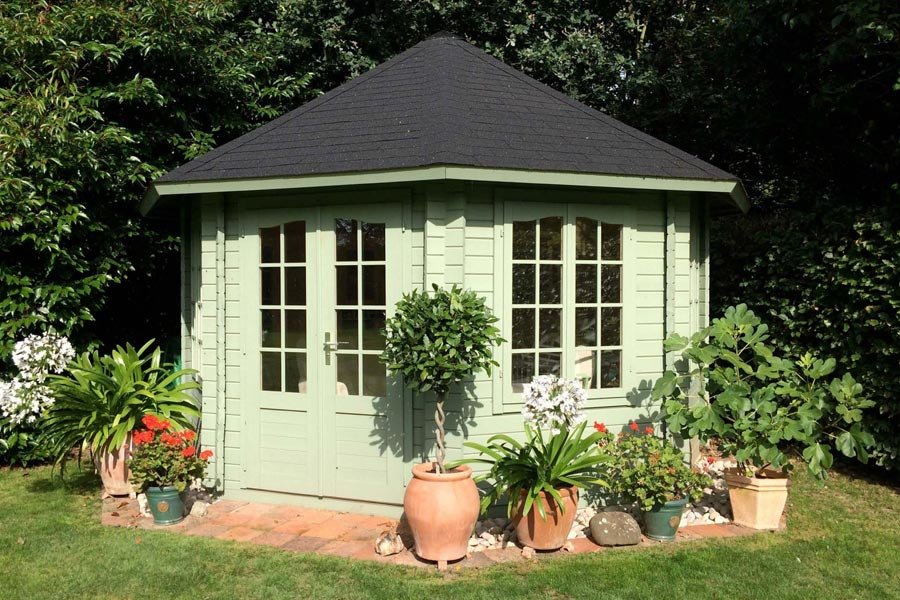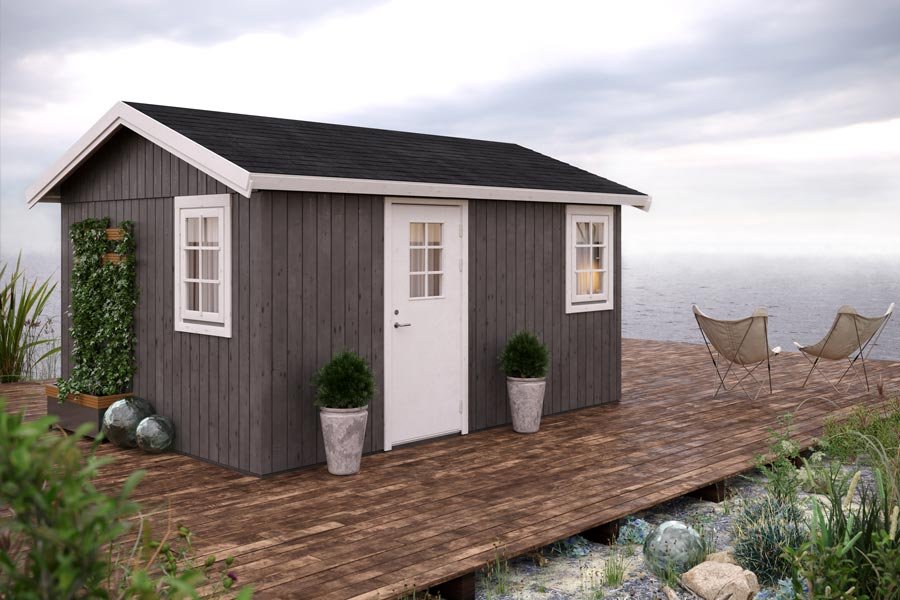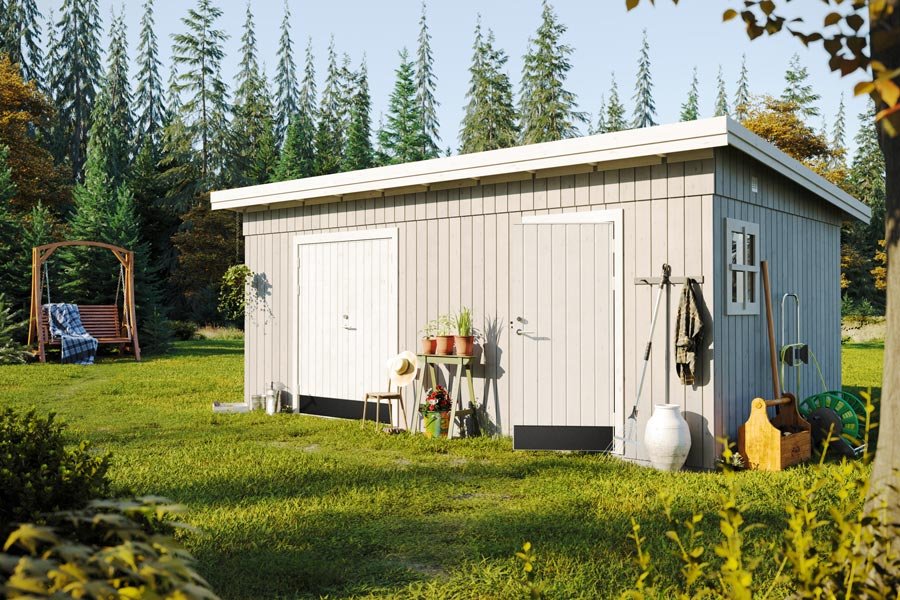
by Mark Bailey | Dec 15, 2017 | GardenLife Magazine, How to guide

Garden security: tips for securing gardens and outbuildings
Most of us are fairly clued up about the security of our homes – with alarms, multiple locks, movement sensors and security lights being commonplace. As a result, crime stats show you were almost four times less likely to be burgled in 2017 than in 1995!
But whilst we’re impressively canny about protecting our homes, too many of us are still prone to neglect the outside of our homes, with little or no thought to garden security. There’s a garden theft around every 8 minutes in the UK and the financial toll can be heavy – especially if you have expensive garden furniture or tools, or a garden office or workshop.
According to one insurance company the most commonly stolen items are bicycles and power tools, but also vulnerable are garden furniture, ornaments, plants and oil tanks. Thefts reported have even included a window, turf, fireworks, and gold bullion!
So here are some easy and accessible garden security tips on how to make your garden and outbuildings more crime-proof.
Natural ways to enhance garden security

If you don’t fancy splashing out on high maintenance gadgetry, adopt a more horticultural security approach – planting prickly ‘defensive’ plants and shrubs like pyracantha, berberis or a native evergreen holly (there’s a good list of thorny hedges on the Hedges Direct website and the Thompson Morgan site has some good suggestions too).
These can make uninvited visitors life decidedly trickier and halt them in their tracks or bring them to your attention (perhaps through their exclamations of pain or annoyance), whilst also looking great. As an added bonus, the berries on shrubs like pyracantha and berberis can also be wildlife-friendly (the RSPB has more useful advice on bird-friendly berries if you are interested).
Spreading gravel or creating a gravel path also makes an inconspicuous approach impossible, while installing wooden or even spiked trellises on top of your walls can deter entry and improve garden security. You could even install planters down your walls and thorny climbing roses or spiky vines to stop people clambering over them. During the day you can enjoy looking at the planting whilst easily avoiding the prickles and thorns, but at night (to unsuspecting thieves) the plants can help to secure gardens and outbuildings.
Improve garden security with structure

Making your garden and its contents more secure need not even require money or specialist equipment and gadgets – the layout itself can help improve overall garden security.
Simple things like keeping hedges and shrubbery low to starve would-be intruders of hiding spots or cover can go a long way. Saga suggests limiting them to around 1m high. This keeps them hard to hide behind, but still tall enough to break up your garden or create the ‘rooms’ so beloved of garden designers.
Also useful is to make sure your house has an unobstructed view of your outbuilding, workshop or summer house – this makes sloping or slightly sunken plots perfect. It’s also wise to locate your outbuildings with the doors facing your main view of the garden with a clear line of site.
What tech can help increase garden security?

The options here can start from £20 or less – with simple security lights or battery-operated shed alarms. You can get a good idea of the options at Maplins or other electronics or DIY/home stores.
Heading up the technology scale, motion-sensing floodlights are popular for improving garden security and can come in at well under £100. That being said, if you have a pet, the strobe-like lighting that can ensue each time it goes outside can get tiresome!
Lights which only come on certain times (e.g. you can programme them to work from dusk till dawn) are also available. You can find a solid selection of outside security lights at sites such as Lighting Direct and The Lighting Superstore.
For garden owners who are more anxious or have more to protect, web-linked CCTV cameras that can stream real-time full HD video to your phone or computer can come in at under £200, although installing them might require a tech-savvy helper and a speedy internet connection.
And although likely the most expensive measure, a garden alarm can both catch and deter intruders – Ultra Secure Direct has a good selection of specialist wireless garden alarm systems (including a telephone and text message alarm disguised as a bird nesting box).
Secure garden outbuildings

If it’s the contents of your shed or office you’re worried about, you might want to upgrade to a more security-conscious garden building. Having a building with sturdy cylinder locks, laminated doors, double glazed windows and 28 – 70mm thick timber walls can all provide added protection, and keep out opportunistic visitors. And into the bargain, you get a warmer, better insulated space for working, entertaining or relaxing.
Does home insurance cover garden security?
Taking out an insurance policy on the contents of your garden – or just checking if your current insurance covers summer houses and garden outbuildings – can also go some way to give you peace of mind should the worst happen. It is worth checking what your current insurer covers; it’s surprising how many policies don’t cover theft from the garden or an outbuilding.
The common sense approach

If it ain’t broke, don’t fix it – if you’re not in the mood to make major changes, simply buying an additional door or window lock will boost your security. As for garden ornaments and statues, well, actually you could fix them – anchors can help make sure no one makes off with them.
Even obvious things such as making sure side or back gates have locks, and then remembering to use them, can make all the difference. Making sure to put garden equipment or furniture back in their resting places can also prevent opportunistic passers-by from making a quick buck at your plot’s expense. Sometimes it’s just the little things that can help improve your garden security and prevent a theft.

by Mark Bailey | Nov 30, 2017 | GardenLife Magazine, How to guide
Put off garden decking ideas by 1990s TV garden makeovers? Don’t be, it offers unique and creative design possibilities, many of which you won’t have ever considered.

Garden decking has become a victim of its own success over the past few years – the subject of so many late 1990s TV garden makeovers that garden designers adopted a sneer whenever they heard the word. And that’s a huge shame, because decking can be used to create brilliant garden designs – practical, affordable, creative and interesting.
With winter greatly reducing the number of other parts of the garden requiring attention, now is a great time to think about decking. Indeed, looking out the window at an under-used muddy back garden could well provide the incentive to use decking to create a more inviting space. Just make sure you wait until the rain stops before installing it – otherwise you may face an epic battle with mud and damp wood.
Here are some ways you can use traditional garden decking to give your plot more interest and functionality.
The classic garden decking BBQ and patio area

This is the best-known use of decking, so beloved of the TV makeovers. There it was used because it was quick, cheap and cheerful – easier to accomplish in two days than actually growing something.
Decking is certainly easier and more flexible than paving or concrete. And it’s ideal for creating a level surface in a sloping garden.
But decking is not just a matter of easy answers. Pinterest has beautiful ideas for using decking imaginatively, and garden writer Anna Pavord recommends getting creative with the colours of decking – looking at shades such as “watered-down green”, soft grey or “patchy olive green”, set off by contrasting flowers in pots. Using decking diagonally or at different angles can also look brilliant.
Vertical garden decking ideas and zoning
Decking need not be limited to the ground – incorporating it vertically into your garden walls can make urban gardens feel more natural, and softer on the eye. And different woods can create different moods – for example, cedar can introduce a Japanese feel.
Decking – horizontal and/ or vertical – can also be used to section off a particular area of your garden or patio, for example to create a raised lounging, play or al-fresco dining area.

Lighting can be integrated into floors and walls – for example, uplighters put into paths and patios for security; downlighters put into decking walls; or LED strips hidden under decking edges. You’ll find some tips and ideas for this at www.exteriorlightsuk.co.uk and www.philips.co.uk.
Speakers can also be set into the woodwork, as can sofas and benches. Planters or trellises can also be incorporated into vertical or horizontal decking designs if you want to break up the wood with some greenery.
Decking or wooden rails can also be used to create a roofed area or pergola, offering some shade and creating beautiful shadow effects. The trick here (as with decking walls) is to think about the spacing of the wood – too close together and the area may look like a sauna.
Garden decking foundations and structures

At a practical level, decking can be invaluable if you’re thinking about installing a garden building. Using it around and underneath garden sheds, storages or summer houses will not only raise them and create a vantage point, it’ll also protect against damp and insects.
Here too, you can be creative, using colour, material and design to contrast or blend with anything from a garden workroom to a gazebo.

You can also combine decking with other structures – from wooden storage units to raised beds or wall-mounted planters – to create interesting textures and surfaces.
Garden paths made from decking?
One reason why decking got a bad name is that people simply ripped out whole lawns or borders and covered them over with an expanse of monotone wood. It’s not just the aesthetic effect people bemoan here; there are warnings that covering over gardens with paving or decking can exacerbate flooding or remove wildlife habitats [PDF].

Buck decking can be used more sparingly to make paths, either raised or flush with the lawn. Not only does this prevent a well-used path across a lawn from becoming a bog, it also create a pleasing ‘journey’ effect that breaks up a space, and is a nice modern substitute for stone or gravel.
Different types of decking materials
The cheapest decking option is usually a pressure-treated softwood, such as pine, available from around £25 sq m. Cedar and redwood are also popular – though more expensive softwoods, with some natural protection against rot and insects. These are usually somewhere from £25/m².
Hardwoods such as oak or teak, although more expensive, are more durable and aesthetic. When buying timber, look for Timber Decking Association-approved wood which tells you it’s of a decent standard.

And then there is composite wood decking – a mixture of wood particles and plastic – which is weather-resistant and hard-wearing but doesn’t look like real timber. There’s more advice about choosing your decking material available on this website.
DIY garden decking ideas – the practicalities

In terms of installation, there are plenty of basic DIY guides online. Useful ones include:
Larger or sloping areas will likely require professional installation – setting you back in the region of £500 or thereabouts – and will probably require planning permission if above 30 cm high. It’s a long-term investment though, given that you maybe able to get 3 decades out of good quality decking.
With all wooden decking, there are practicalities to think about. If neglected, a decking path may turn into an ice rink in the winter months, fitting it with chicken wire could be useful. There are also anti-slip solutions from providers such as Gripsure and Deckwright, which can prevent damp decking from turning into a slippery, slimy health and safety hazard, and are readily available in DIY chains.
And finally, on the maintenance front, all types of timber decking will need to be cleaned, sanded and resealed every year or two. For basic cleaning – preventing or dealing with the dreaded algae – there are plenty of cleaning products available in DIY stores. There are some eco-friendly cleaning recommendations on the Amatuer Gardener website.
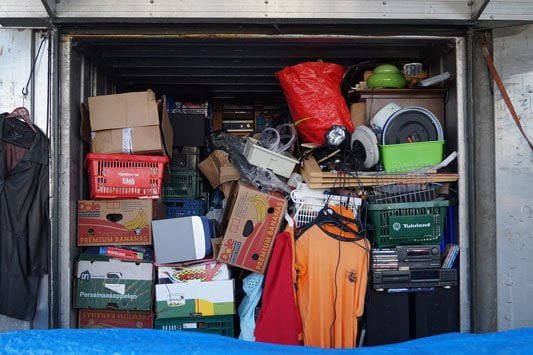
by Mark Bailey | Oct 19, 2017 | GardenLife Magazine
Too much stuff? What you need are some helpful ideas for self storage solutions and other alternatives.

Lots of stuff; but not lots of space. It’s a growing problem for many of us, as modern flats and houses get smaller, and the number of things we accumulate grows ever bigger.
And however good our intentions to de-clutter and get rid of possessions that don’t ‘spark joy’, it’s difficult in practice. It seems heartless to throw away children’s artwork and old wedding gifts; and downright stupid to rid yourself of all your winter clothes because you don’t have enough hanging space.
So, for most of us de-cluttering is more about finding cost-effective self storage solutions than divesting ourselves of the stuff we own. But what are the best self storage solutions, and what are the realistic alternatives?
Self storage solutions: size, cost and extras

Self storage units are long favoured by students, urban renters with a lack of space, and people moving house. They’re affordable, flexible, and increasingly accessible. And certainly more manageable for most people’s budgets than renting or buying somewhere bigger to live.
In the UK, self storage units tend to range from a tight 2.25 sq m (the size of a small garden shed) to around 15 sq m (roughly the size of a double garage). If you’re renting on a short-term basis, expect to pay upwards of £10 a week for the smallest units, rising to £50-plus a week for 15 sq m. But price will vary significantly depending on location, size, length of contract, and the type of unit you want.
Many self storage units offer additional features such as 24-hour access, van hire, air conditioning, lighting, forklifts for heavier items, and CCTV – expect to pay extra for these. Committing to a longer contract can reduce the price per week, and it’s worth shopping around.
There are plenty of online storage comparison sites, which can tell you your local options and give ballpark prices. Compare The Storage and Storage Price Comparison are both useful here.
And if you want generic advice about using the best self storage solutions there’s good advice and FAQs on the Self Storage Association website.
Self storage isn’t a solution for everyone
Self storage is burgeoning, but there are downsides too. Location, for a start.
Given that self-storage units are usually contained in vast warehouses, you may have to drive to an out-of-town industrial park to access your stuff. Problematic for rural or urban dwellers, or those without a car.
In addition, the interiors can be labyrinthine, confusing or a depressing place to spend a Sunday morning, and the quality and convenience of the storage can vary widely.
So, on what’s on the menu if you want to keep your things closer to home?
A home extension instead of self storage?

If you can’t shrink your stuff, you need to grow your space. Option one is a home extension. You probably know all the pros here – adding value to your home, getting exactly the storage and living space that you want, in a style that fits your taste, and makes the most of modern building efficiency and insulation.
That’s the upside. You’re probably just as familiar with the cons – the upheaval, the planning processes involved. And the costs.
As with most self storage solutions, the costs of an extension will depend on location, size, materials, single-storey or double-storey etc. The rough rule of thumb for extensions used to be around £1,000 per sq m for a single-storey extension, but the Design For Me website (which has a useful price estimation tool for extensions) suggests more like £1,200-£2,000 per sq m.
And that doesn’t include professional fees, fittings, unexpected costs and overruns, and all the rest.
Garden storage solutions – easier on the pocket and your patience

Option two for extending your space is to think about garden sheds, workrooms, garages and offices. They’re a much cheaper and more flexible alternative to an extension, and may cut out the need to go through the planning permission process. And you still get to store your stuff securely and close at hand.
If your idea of a garden building is still a one-person potting shed, it’s time for a rethink. You can now find attractive garden buildings for storage (or living, working or entertaining) measuring anything from 4 sq m to a whopping 25 or 30 sq m, in any style from Dutch barn to contemporary urban garden office. They are all designed to be built by those with even the very basic DIY skills too.
Price-wise the garden building option comes out well when compared with both long-term self storage and home extensions.
Take self storage solutions. Let’s say you pay £50 a week for 15 sq m of self-storage, or upwards of £2500 a year. And then let’s say you look at a solid timber garage or garden workroom at around £4,000, with 19 or 20 sq m of space – not only has it paid for itself after 2-3 years, but you also have a flexible asset in walking distance of your own door.
If it has outlived its usefulness as a storage space, some minor fixes can turn it into an outdoor office, children’s den, extra living room or whatever else takes your fancy.
What to look for
If you’re going to store your precious possessions in a timber garden building, you want them to stay safe, usable and in great condition.
So, whilst saving money (compared to an extension or a self storage solution) may be the motivator, don’t cut cut your budget at the expense of durability, weather-proofing and security:
- Buying a cabin with thicker chalet-cut tongue and groove cladding will provide a more robust solution than cheaper sheds with overlap cladding
- Slow-grown timber is denser and more robust than quicker-grown timber. Look for wood grown in Nordic countries, since the denser grain will make it less likely to warp, twist or split, and will provide better insulation.
- Features such as toughened glass and secure locks will help protect your possessions from unwelcome visitors.
- Pay attention to suppliers’ instructions around wood preservation treatments, and the base to build your cabin on. This will help prevent damp, mould and other weather-related problems.
- Check to see if your timber garage or garden room can be dip treated before delivery to better protect it.
With a wide choice of self storage solutions, a home extension, or even a new garden room that you can build yourself, there should be something to match your budget and needs.

by Mark Bailey | Sep 21, 2017 | GardenLife Magazine, How to guide

Smartphones and gardening apps are not the first thing to spring to mind when you’re thinking about good tools for the garden. But modern technology has made gardening easier and more accessible than ever.
Answers to gardening problems or tips which once required a trip to the library or garden centre are now being carried around in our pockets, just a few taps away.
Here are a few of our favourite gardening apps to fuel your passion for all things green or improve your own patch.
The best garden planning app
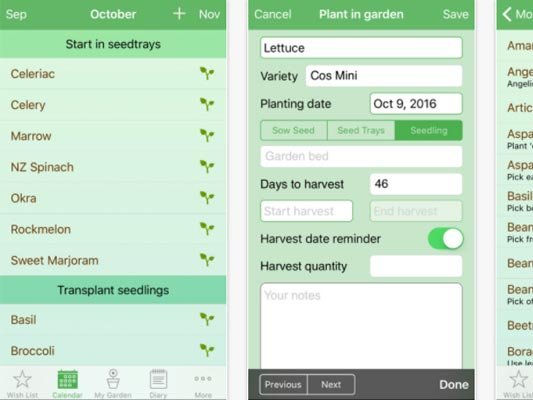
Garden Plan Pro – iOS, £7.99
Many of us have good intentions about growing our own fruit and veg or applying for an allotment, and then don’t quite get around to it. The Garden Plan Pro app could be the jump-start you need to get planning, digging, sowing and harvesting.
Don’t be put off by ‘Pro’ in the title – it’s aimed at beginners and allows you to create designs and your own ‘3D’ models of your ideal garden to see how it could all piece together – even telling you the ideal spacing for plants, and what plants would grow well next to each other.
What’s more, if you enter your location it will give you articles/tips etc for your own climate, as well as send you weather updates (eg a warning of frost on its way), and planting or harvesting reminders.
It’s certainly not the only app of its type on the market, but it’s a practical and user-friendly starting place.
The best garden scheduling app

Gardenate – iOS and Android, 55p
Timing can be everything in gardening, especially when it comes to planting and harvesting, and it’s one of the most daunting aspects for the beginner.
The 55p Gardenate app helps with this, by making a calendar on your phone with all the key timings – fertilising, feeding and so on – for just about any vegetable or herb you can think of. It also offers suggestions on the perfect plants to invest in depending on your climate and time of year.
The app covers Australia, Canada, New Zealand, South Africa and the USA, as well as the UK, so it’s quite generalised. For the UK, it has just two zones – cool/temperate for the north and west, and warm/temperate for the south and east – so the advice is not localised enough for some people’s taste. But it’s a good general guide, with a simple and lucid layout that’s intuitive to use.
Best gardening apps for identifying plants and weeds

B&Q Gardens App – iOS and Android, free
Not sure whether the thriving plants in your garden should be there or not? The B&Q Gardens app has a tool to help you identify common weeds and learn how to deal with them (using products from B&Q, of course).
There’s also an image recognition tool allowing you to take pictures of flowers you like (or that you have in your garden and don’t know what to do with), and identify similar ones in the B&Q range.
If you don’t find what you’re looking for on the B&Q app, there are plenty of other free or paid-for apps that will help you identify a mystery plant by uploading a photo.

Garden Answers Plant Identifier app – iOS and Android, free
Garden Answers app will identify plants from a photo you upload (using a data base of around 20,000 species). It’s also useful for novice gardeners as it has an enormous 200,000 strong library of common questions. The app itself is free though if you want an expert’s detailed advice on anything, there’s a fee.

SmartPlant (previously called PlantSnapp) – iOS, free
Another popular plant identification service, with the option of monthly care advice and reminders, and an ask-an-expert service (though note that a fee is payable for this last feature).
Best garden finder app

National Garden Scheme app – iOS and Android, free
If you’re looking for inspiration or just like exploring new spaces, the National Garden Scheme app is ideal. It shows you the location of almost 4,000 gardens open to the public as part of a charity scheme which raises money for nursing charities.
A quick search will show you all your local venues although bear in mind that most require a small entry fee or donation. Some gardens may also sell plants or seeds.
Best gardening app to make friends and influence people

Garden Tags – iOS and Android, free
Seeking to gain inspiration or advice from other enthusiasts? Garden Tags is a community-based app where gardeners share tips and tricks.
Think of it as a social network for all things garden where you can ask open questions or broadcast your progress. You can also play around with other useful features like the built-in gardening encyclopaedia.
Best rainy-day gardening app

English Garden app – iOS and Android, free
A handy digital version of the popular magazine, the English Garden app is ideal for those with a general interest in gardens, irrespective of whether you have one or not.
The app is free, but you have to pay for each copy. A number of other glossy gardening magazines also have good apps – for example, Gardens Illustrated and BBC Gardeners World – they’re all very professionally done, though bear in mind that their main aim is to get you spend money on subscriptions or single issues.
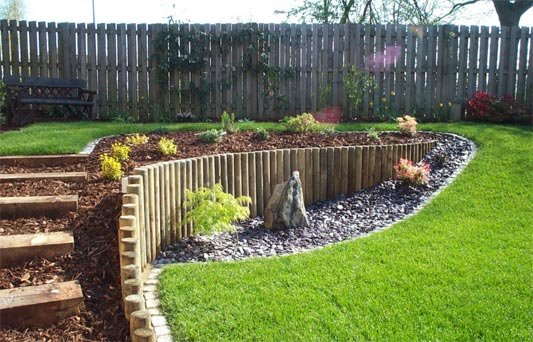
by Mark Bailey | Aug 18, 2017 | GardenLife Magazine, How to guide
Sloping garden design inspiration

5 ideas for hillside garden landscaping
Designing your dream garden can be daunting at the best of times; if you have a sloping patch, things can seem especially tricky. But there are a host of ways to work around the tilt.
Here are 5 tips on how to turn your garden’s awkward angle into an asset. They’ll help you conquer some of the commonest problems with poor sloping garden design – such as difficulties with mowing the lawn, half of the garden being un-used or un-usable, or soil erosion.
They’ll also give you alternatives to expensive and heavy-duty landscaping and retaining walls.
Include terracing in your sloping garden design

The traditional way to overcome your garden’s gradient is terracing – basically turning a slope into a series of flat surfaces with different levels and steps.
This makes gardening simpler, and allows you to use different styles on different levels.
Terracing materials can also be an intrinsic part of the sloping garden design. You can use a whole range of materials to terrace your garden, including different types of stone, wood, metal sheeting, brick and even old tyres. These allow a choice of eye-catching surfaces if your garden slopes upwards, and you’ll find plenty of inspiration on websites like Pinterest and Houzz.
However, if your garden slopes downwards, there’s less opportunity to create interest through the actual terracing materials.
The downside of terracing is that it can be intensive in terms of effort and cost, particularly if your slope is steep. Unless you fancy a challenge, have a tiny plot or really know your stuff, it is wise to consult a professional landscaper or builder. But a good garden designer will be able to suggest cheaper alternatives to building expensive retaining walls and foundations, as this blog on using old railway sleepers in a design shows.
Another cost-effective option for creating terracing is gabions. These are wire cages filled with stone, commonly used in civil engineering projects, such as road building, but used in garden landscaping too. They can be cheaper than building retaining walls, and also look more contemporary, as an interesting blog by Alda Landscapes shows.
Use planting to improve your hillside garden

A great way to manipulate the feel of your sloping plot is to play around with what plants you place where in the garden. For example, on land sloping downwards from the house, planting tall foliage at the bottom can reduce your perception of the tilt.
However, planting tall plants or trees at the high end of an upward-sloping garden could make it feel enclosed and overpowering. And looking upwards at a border can make tall plants look absurdly tall and dominating. So, as this advice in the Guardian shows, if you plant a border on a slope, you may have to relearn the rules about what should be planted where.
Plants can also be used to stabilise a slope and prevent soil erosion. There’s a good selection of low-maintenance, groundcover plants suitable for the steepest of slopes on this site, and they can add colour and texture to your sloping garden design..
Decking in a sloping garden design?

Installing decking and creating a wooden patio-type feature at the bottom of your garden can look really good as it will give the garden a focal point and catch the eye (in turn drawing attention away from the slant). It can also transform a neglected, unloved part of the garden into a social area, where you can entertain.
It can enable you to install a showpiece structure (which could be otherwise impossible given the incline) such as a water feature or pergola which is sure to be seen. And installing a garden shed or summer house on decking means you don’t have to worry about uneven, sloping foundations, or water pooling.

Do, if you have neighbours close by, do careful about installing a summerhouse or shed at the top of a garden slope – the effect could be a bit like a watchtower, with the neighbours feeling they’re under unwelcome scrutiny all the time (the photo above is of the lovely GardenLife Claudia clock-house style summer house positioned right at the top of a steep slope in a customer’s back garden – not our call).
For ideas on how to use decking in sloping gardens – plus words of warning about some of the pitfalls – have a look at the top deck website.
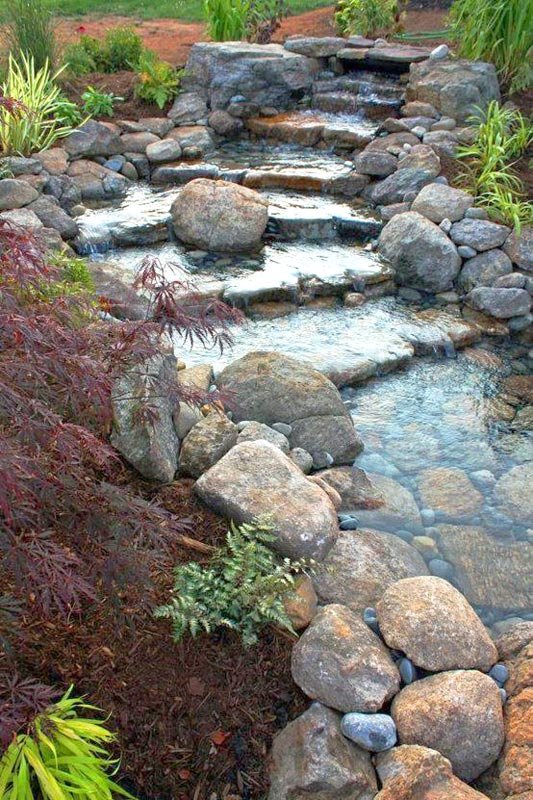
This is an aspect of sloping garden design where an angle is actually really useful as it gives you scope to install kinetic water features. Instead of a sedentary pond, you could have multiple pools connected by streams or small waterfalls (since the slope and gravity will do most of the work for you) – your very own miniature version of the famous waterworks at Chatsworth.
Or you could create a mini river-rapids style rock cascade – the Falls of Clyde in your own backyard. Having a dynamic feature like this could really command attention and bring the garden alive.
If you don’t have Chatsworth’s Capability Brown to design your water feature for you, there’s a good selection on the Primrose website.
Paths in a hillside garden
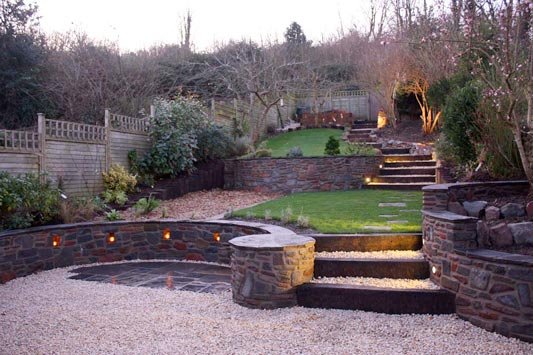
If terracing or decking are too high maintenance and/or costly for your sloping garden design, creating a inclined, winding walkway can reduce a slope’s prominence (whether it slopes upwards or downwards) and create a journey-like effect.
An S-shaped path with large sections of foliage will break up the space and take attention away from the slope whilst the hillside will give the path dimension.
However, if your garden’s list is particularly drastic, getting up or down path could prove impractical in winter weather or for the elderly, even if the path snakes across the hillside.
There is good basic and practical advice on building a garden path on the Wickes website.
Whatever you choose to incorporate into your new sloping garden design, the inspirational ideas, examples and links above should help get you started.
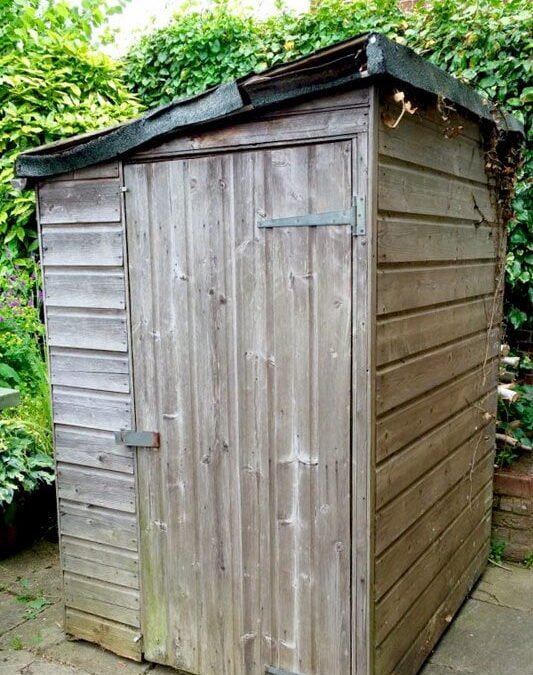
by Mark Bailey | Jul 20, 2017 | GardenLife Magazine

The best alternative to an overlap garden shed
Shiplap, weatherboard, tongue & groove, chalet cut; what’s the best alternative to an overlap garden shed?
If you’re buying a timber building for your garden, you want it to last. After all, why bother choosing and erecting a garden shed, workshop, summer house or office if it’s going to turn rickety, draughty or damp? Last year’s bargain overlap garden shed can quickly turn into next year’s source of regret.
So, how can you spot quality and durability when you’re buying a timber shed?
By looking at the wood, the build and the details. And you don’t need a background in joinery or construction to know what to look for.
With overlap, know what you’re getting, and you’re not getting much
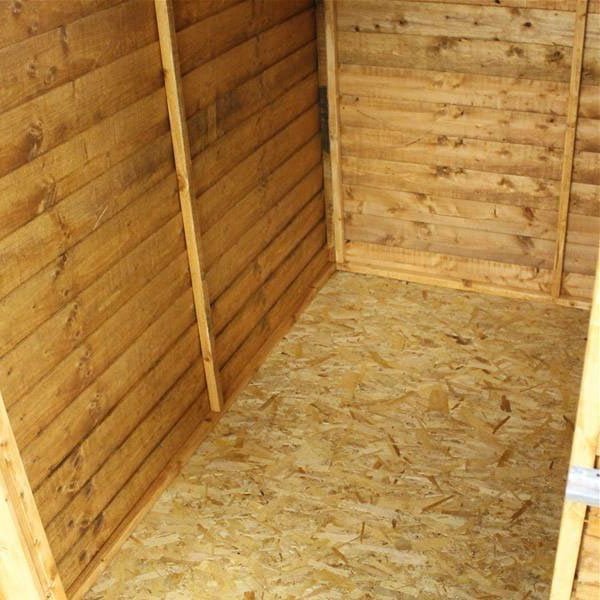
Bargain garden sheds often have ‘overlap’ cladding – each thin piece of timber overlaps the timber beneath it, so that rain runs straight down the side. These sheds are cheaper than other types of cladding but they’re susceptible to warping and not very durable (overlap garden sheds often only use panels between 9 and 12mm thick).
Overlap cladding also can’t support anything heavy such as shelving on the internal panels – not exactly what you want for a workroom, storage area or office.
The alternative to overlap panels? Individual chalet cut timbers
Many overlap garden sheds (and also tongue & groove sheds) come with prefabricated cladding panels which you screw into place. The attractions are obvious – they’re fast to build.
The disadvantages are less obvious – for the first year or two at least. But after your first couple of winters, you may see warping in the timber. This is because wood swells or contracts according to the weather, which will take its toll on the build. The thin timbers can break (a risk that increases with age) and if the ground isn’t perfectly level they can begin to lean.
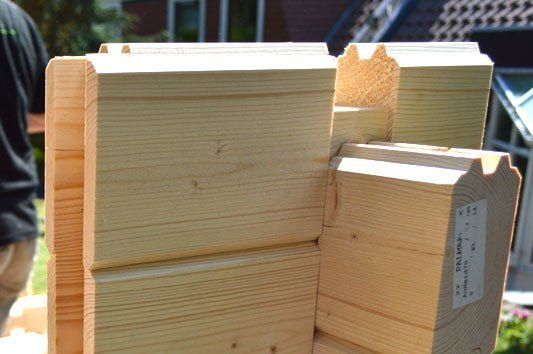
The best alternative to an overlap garden shed is a garden building that uses individual chalet cut tongue and groove timbers that physically slot together and intersect at the corners. GardenLife Log Cabins use this technique because the 28 – 44mm thick timber is far stronger, sturdier and long lasting, plus the individual timbers tighten and lock together during cold weather.
A garden building erected with individual chalet cut timbers may take a day to build (instead of a couple of hours for an overlap shed) but the pieces slot together like Lego bricks and they are designed for simple step-by-step self assembly.
An office with 12mm overlap timber panels? Forget it
Another disadvantage with overlap sheds is that the timber can be thin. Very thin.
As mentioned above, many budget overlap sheds use 9-12mm timber – either for overlap cladding or tongue & groove. Try sitting in one of these sheds after sundown or in autumn and winter, and you’ll quickly realise why Nordic shed-builders (who know a thing or two about timber) tend to use solid timber between 28 and 44mm thick.
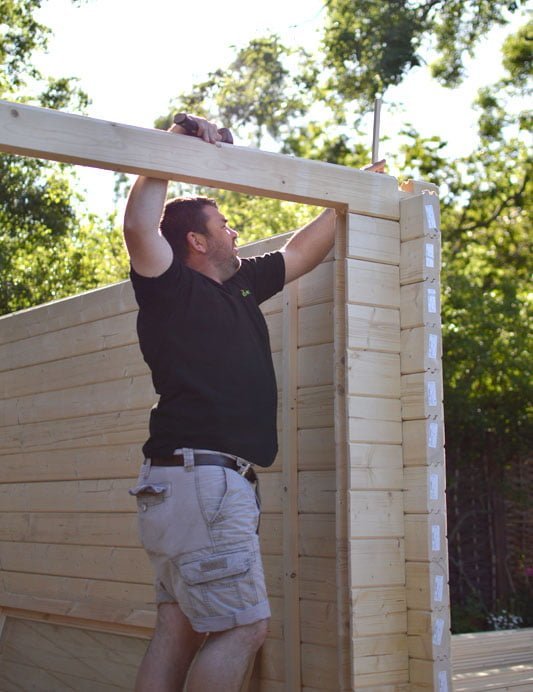
With our own range of chalet cut timber garden buildings, we generally advise that 19 – 28mm thick timber walls are ideal for use in summer, with 28mm insulated enough for spring and early autumn use too.
Thicker timber – 34mm, 44mm or even 70mm – provides enough insulation and warmth for all-year round use – important if you’re looking for a workroom or garden office.
So, a 12mm overlap shed may look like a bargain. But you could end up spending all the money you save on buying polar exploration clothes to wear while you’re working.
There’s wood and then there’s wood
When buying a timber garden building, you want wood that’s dense and solid. And, in general, wood that grows slowly has a denser grain than fast-growing wood. That’s not the case with most overlap garden sheds (and also tongue and groove sheds) which tend to be made from pine softwood.
For this reason, GardenLife use Nordic spruce – the colder Baltic climate means it grows more slowly than Mediterranean wood. That means you get a more robust, solid building with greater structural integrity and weather resistance. The timber offers better insulation, and is less likely to warp.
Look north for great ideas
Another Nordic area of expertise is design. And one design idea we love is the concept of the Quick Fit range of garden buildings. These easy-to-build cabins have 18mm timber, a windproof internal membrane, and optional insulation that fits directly into the wall cavities, and can be hidden behind internal cladding for a smarter finish and a warmer environment.
Overlap just can’t compete – neither for warmth, nor for style.
What do heads and toes have to do with the best alternative to an overlap garden shed?
You know how the key to keeping warm in winter is to pay attention to your feet and head? How even the thickest coat won’t keep you warm if your feet and head are not covered up properly as well?
Think of the same principle applying to sheds and garden buildings. If you’re looking for robustness, longevity and insulation, check out the floor and the roof as well as the walls.
The OSB floors and roof that you’ll get with many budget overlap garden sheds just can’t match the better insulated, more durable 16-19mm thick tongue & groove roof and floor boards that we use at GardenLife. If you’re looking for the best alternative to an overlap garden shed and the description mentions OSB, look elsewhere.
The ins and outs of choosing doors
With doors, the same rules apply as with the walls. Overlap or tongue & groove doors will be flimsier and more likely to warp than solid doors. The words “security” and “overlap” combine just as well as oil and water – regardless of the type of lock used a 12mm overlap door panel is easy to break into (a good kick is all you need).
You should also pay attention to door frames. This is one of the first places where problems will set in with cheaper overlap sheds, with frames warping and doors (or windows) not closing properly. Once this happens, it’s extremely difficult to do anything about it and water will easily penetrate the interior.
So, look at the detail here. For example, are door frames laminated, or pressure-treated? And are door sills made of hardwood or metal, so they can withstand the passage of damp shoes going in and out? Many GardenLife buildings feature doors that are made from laminated Nordic spruce that offers true strength and rigidity as well as increased protection.
Not a details person? Maybe you should be
Look at the details of accessories and options. Are there secure cylinder lock doors or cheap fasteners or handles that require an optional padlock? Real glass windows – perhaps double-glazed – or just Plexiglass?
Such details could make a real difference to how your shed withstands the challenges of time and weather over the next few years, and therefore how much you still love and use it day to day.
The very best alternative to an overlap garden shed may be too expensive, not everyone’s budget would allow for a solid 70mm timber, double-glazed, multi-roomed garden building, and there are always compromises you’ll need to make to find a shed that fits your budget.
But if you do want to keep the cost down, it’s important to understand the different trade-offs and economies you can make – which ones will prove false, and which ones will still get you a long-lasting and well insulated garden building that will suit you for years to come. Cheap and easy doesn’t always stand the test of time.

by Mark Bailey | Jun 23, 2017 | GardenLife Magazine, New garden buildings, Website updates

New summer houses, sun rooms, sheds and more
Until recently, garden buildings generally came into two versions (and designs for new summer houses with few and far between). There were sheds, which were mostly utilitarian, and standard summer houses, which were mostly draughty (and often just looked like large sheds). Beyond that, the choices mainly involved deciding between large, medium and small, and, perhaps, what the doors were like.
In 2017, the picture looks very different. Garden buildings are now integral to how many of us live – places to work, entertain, chill out or exercise all year round. Because of this, the old choices of shed versus summer house, large versus small don’t cut it anymore.
Summer houses with bi-fold doors
At GardenLife, we continually add new models, designs and features to our range of timber garden buildings. We’re always in pursuit of your ideal – helping you find the dimensions, layout and design details that perfectly match your aesthetic or the way you want to use a garden building.
Take the new choices we’ve added to our range this year (some of which we’ve teased our Facebook followers with):

Already proving popular are our new bi-fold doors, available on our Ines and Lea summer houses. They open up most of the building width, ideal for parties or enjoying the sunshine.
The doors are double-glazed, insulated enough for year-round use. And to maximise light and airiness – in summer or winter – both models have optional side windows.
A gazebo with glass or timber sides (or neither)
‘Optional’ is a word we use a lot at GardenLife. As great believers in flexibility, we offer our new models with different configurations.

With our Lucy gazebo, for instance, you can have it with open sides; with solid timber wall elements; or with an option we’re especially proud of – wall elements with glass panels. You can tailor it perfectly to your garden and preferences, having wind shelter and views exactly where you want them.
New summer houses in different sizes, configurations and shapes
Another model that spoils you for choice is Melanie, now available in six– yes, six – sizes and configurations.
The underlying idea is the same for all six– it’s a corner summer house (for efficient use of garden space) with views and light on three sides. But you can choose between different dimensions or window sizes, and even add a splendid 8.3 sq m of covered space – somewhere for a barbecue, sandpit or hot tub, perhaps?

Other new sun rooms also come into different sizes and shapes. For example, Mary has the option of different sizes or roof extensions – great for storing logs, bikes or other equipment.

And our popular Lotta and Klara log cabins each come in three sizes. And we’re not talking small variations here.
The smallest version of Klara offers a useful and attractive 4.7sq m – perfect for a playhouse, summer house or painting space in a compact garden. In contrast, the largest Klara cabin has a whopping 17 sq m of space – enough for an entire painting class or army of small children.
On trend: new wood treatment and roof options
Another innovation for this summer is our new dip treatment options. As before, you can buy the cabins untreated, and apply wood preservative yourself. Or you can now buy them dip-treated, to protect the timber against mould, rot, wood-destroying fungi and insects.

You can choose between:
- grey, which makes the timber look aged and weathered (in a good way)
- brown, which intensifies the natural appearance of the timber, making it richer in colour
- clear, which gives you a blank canvas for any paint colour
On roofs too, there are new choices, with shingles now available in black, red and green.
And the rest: from a stunning verandah to guinea pig paradise
If you’re not already dazzled by the choice of new summer houses and sun room designs, we should mention a few new styles that are far outside the traditional shed/garden building spectrum.
A stunning addition is the Agneta garden cottage. As you’d expect if you’ve read this far, it comes into a choice of sizes. The larger version has a huge terrace on two sides – so much verandah space, you’re practically in Gone with the Wind territory.
Less grand but more contemporary and urban are Hedwig and Ethel – both slick, QuickFit designs with modern fine-sawn cladding – as well as large multi-room storage sheds Jari, Olaf and Kalle.
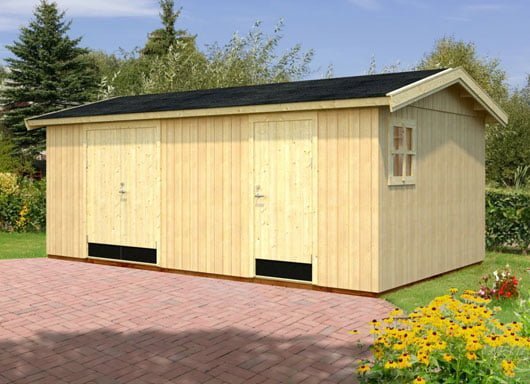
And last but certainly not least, there’s Roger, a seriously large and robust garage that could fit not only a large vehicle but probably several record collections, old mowers, a table football table and every bike your children have ever grown out of. And with 70mm timber walls, this garage should be warm and insulated enough for even the most pampered of guinea pigs.
So there are plenty of new summer houses and design features to tempt you, but as ever, we’ve kept the details that set our range apart – slow-grown timber, solid construction, robust fittings, durability, and good service. If you’d like to chat through any of the options, choices and practicalities, just get in touch – we’d be delighted to help.

by Mark Bailey | May 19, 2017 | GardenLife Magazine

What could gardening in a changing climate mean? An end to spring frosts? Palm trees or eucalyptus in your back garden? A green roof on your home or garden building?
They’re just some of the possible effects or opportunities that climate change could bring to you and your garden, according to a new report from the Royal Horticultural Society, called “Gardening in a Changing Climate”. Other possible impacts could include year-round lawn mowing, an increase in weather ‘events’ such as flooding, and an influx of new pests.
Fortunately, the RHS report has ideas for mitigating and adapting to these less welcome consequences of climate change.
North, south, east and west: the new gardening zones

Exactly what new opportunities and risks you face from climate change depends on where you live. Those in the south and southeast of England will face generally hotter and drier conditions throughout the year, though with occasional heavy rain showers. Further north, the weather will be milder than at present, but also significantly wetter and windier. The west will also see higher rainfall and warmer weather.
So while those in the southeast will be pondering issues around water conservation, and new possibilities around plants suited to arid conditions, those in the north, and also the southwest, will more likely be concerned with managing excess water, through solutions such as green roofs (to minimise run-off) and raised beds (to prevent plants being waterlogged).
Given these new conditions, when it comes to climate change and gardening you may need to rethink some of your approaches to the different parts of your garden, wherever you live.
Climate change and garden lawns

Lawns and turf will be particularly vulnerable to dry spells on one the one hand and wet ones on the other. Milder temperatures and higher rainfall in the west will extend the growing season – hence mowing may become necessary year-round (though waterlogging may make this difficult). But in the drier east the struggle to keep grass green may become too much of a chore, and the perfect English sward may become a thing of the past.
The options include converting lawns to borders, raised beds, dry meadows, gravel gardens, or – if you still want to look out on an expanse of green – an artificial lawn. If the latter already seems an attractive alternative to year-round mowing or a parched dust patch, you can see a good selection of artificial lawns on the Homebase website.
Choosing plants for gardening in a changing climate

Changing conditions will obviously affect the plants that you can grow and how well they do. Some gardeners will need to find out about drought-friendly plants such as agaves or blanket flowers, and perhaps read the useful article about drought-resistant gardening on the RHS site.
Meanwhile, other gardeners will be best seeking out a different article, about gardening on wet soils, and to gen up on plants that flourish in very wet climates such as hostas.
In addition, plants such as clematis and buddleia that are robust at withstanding wind, rain and whatever else the weather throws at them will become even more beloved to British gardeners than they are now.
One other thing to consider with climate change and gardening is that warmer summers will create prime pest conditions and aid the spread of diseases. It might therefore be useful to look at long-term anti-insect and pest protection solutions, such as planting sunflowers to attract pest eating bugs. There are some good ideas along those lines on the Grow Veg website.
Trees ideal for climate change and gardening

We’ve already mentioned the new opportunities here – from palms to olives to almonds – for those in the drier, hotter south and southeast.
But climate change may also bring more extreme winds, rainfall and other weather events, and warmer temperatures may up the requirements in terms of pruning. According to the RHS report, larger trees in wet soil are more vulnerable to wind-toppling, so smaller tree varieties will look more attractive. It may be time to start investigating the possibilities of small fruit trees or hardy softwood natives.
Gardening in a changing climate means that it is also worth thinking about trees that are able to withstand extremes of hot and cold temperature – the RHS report specifies spruce, Norway maple and Scots pine in this regard.
Do your bit for climate change in the garden

Most of us will probably have to adapt our garden plans in future, but we can also do our bit to mitigate climate change by making our gardens more eco-friendly right now.
Little things like using energy-efficient garden power tools and solar lighting; using peat-free compost; installing and using water butts, and avoiding pesticides and fertilisers with a high carbon count can all help to reduce any negative environmental impacts of your garden.
And if you’re thinking about garden design or some home improvements, bear in mind that green roofs and walls can reduce energy usage in homes and other buildings (not to mention providing food and shelter for native birds and insects), and planting trees and shrubs can help to lock up carbon from the atmosphere.
Converting concrete drives to gravel also reduces the chance of localised flooding as water can soak slowly through gravel instead of rushing straight into drains.
Growing your own fruit and veg helps too. A recent study showed that for every kilogram of vegetables you grow yourself, you could be reducing greenhouse gas emissions by as much as 2 kilograms (compared to buying from the supermarket).
For more tips on what climate change may do to your garden, how to adapt to it, and how to avoid your garden making it worse, you can read a summary of the RHS report.
If you want the full 80-page “gardening in a changing climate”, it’s available to download here.
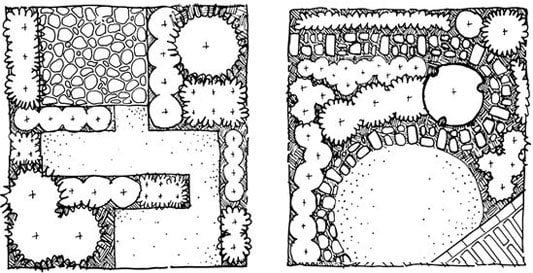
by Mark Bailey | Apr 3, 2017 | GardenLife Magazine, How to guide

Square garden design – how to best transform your limited space
This month in our series on garden design ideas for different shapes of gardens, we’re tackling an all-too-common horticultural gripe; how to come up with a unique small square garden design. If you live in an urban or suburban area, it’s quite likely your garden is a little square-ish shape – not exactly the stuff of garden design fantasies.
But don’t be defeatist – with the right tricks, your handkerchief of a backyard can be transformed into a far less square, more spacious-looking area. To help you do this, here are 6 tips to create an inspiring and roomy square garden design with your box-like plot.
Curved lawns complement a square garden design

Let’s face it – a square garden with a square lawn isn’t particularly exciting. If you want to jazz things up, try changing your lawn shape – circular, oval or curved irregular shapes will all distract the eye from the box shape, and make your garden appear more creative.
Curves and arcs also create more opportunity for interesting borders, beds or small vegetable patches, or for foliage to break up the lawn. However, when using foliage to create visual interest, be wary of shrubs that are likely to grow too vigorously outwards – they will end up turning a compact square garden design into an even smaller one.
If you decide to use lawn shapes to break up the square, lawn edging is essential to keep the lines crisp and defined. Have a look at the different options for edging materials (from metal to bamboo to eco-materials) on the Primrose website.
Complement or contrast with borders and paving

Having borders, walkways and lines in your garden can take away from its squareness and create more of a visual (as well as physical) journey around the garden.
This approach can also help you create different sections, for example, a sinuous path to a relaxing or dining area can transform the look of the garden, and also the way you use it.
Wooden boardwalks are inexpensive but if you’re after a more robust alternative, stone bordering and edging are more versatile in terms of shape. And if you decide on a border for your new square garden design, there’s an inspiring ‘cheat’s guide’ to starting a border detailed in this article on the Guardian website, including the very tempting Garden on a Roll that does virtually everything for you except dig the bed.
Add height, steps or levels to break up your square garden

Introducing differing vertical aspects to your garden will help spruce up its appearance and profile as well as creating more interesting features.
You can combine this approach with the ‘journey’ tip above by raising your walkways or perhaps giving your decking some height, perfect for an al fresco dining section. Even a larger structure like a pergola or arch can do the job, as can raised beds around a central lawn.
A more natural approach is also effective – a row of small trees or tall plants like delphiniums contrasted with low plants can create interest and intrigue. There are some good ideas for tall border plants on the Thompson & Morgan site.
Use the walls or fence around your square garden to enhance it

In too many suburban and urban gardens, the walls or fences are bland or even ugly – they restrict your garden and act as boundaries, without actually adding any visual interest at all.
An excellent way to combat this can be to incorporate the boundaries into the design. Planting climbing plants up trellises on a wall or fence will create a more natural and organic feel, and make the garden feel less confined, without eating up as much space as a border.
You could even hang flower baskets or planters on a wall or fence, extending the planting space if your garden is tiny. For a good selection of wall planters have a look at the Woolly Pocket site.
Alternatively, try integrating raised beds with seating areas or a fountain into the fence or walls around the edge of your square garden design.
Sectioning; break your square garden into different zones
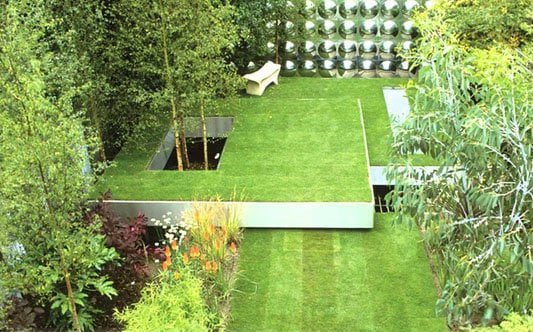
If you can take in everything in your garden at first glance, its squareness is going to be immediately obvious.
A great method to fix this is to compartmentalise your garden into different sections with different purposes. You can divide using borders, tall plants or trellises.
A dining area either right next to the house (for convenience) or at the far end of the garden (for a more getting-away-from-things feel) could be useful, while a shady spot, kids’ play area or small vegetable patch could be useful and easily accomplished.
There are some inspiring ideas for small gardens (though not all of them are square in shape) on the Ideal Home website.
Add a structure or garden building to disguise the square shape

Having a focal point to grab the attention will disguise the squareness of your garden – whether a pergola, gazebo, summer house or garden office.
Bear in mind a non-square or non-rectangular shape will likely achieve this goal better, as well as using space more efficiently, so look at corner buildings and circular or hexagonal shapes.
Remember that, in most circumstances in the UK, a building within 2 metres of a boundary wall will require planning permission if it is over 2.5m high, so take this into consideration when choosing a structure. Garden Life has a wide selection of sub-2.5m buildings available here.
Hopefully these tips and inspirational ideas will help you generate some great ideas for your own square garden design.

by Mark Bailey | Mar 21, 2017 | GardenLife Magazine, How to guide

Want to grow your own veg? 7 tips for planning a vegetable patch
Whether to fuel your gardening passion, improve your eating habits or occupy some free time, vegetable patches can be a surprisingly fruitful (excuse the pun!) and rewarding endeavour. With spring here, you might be thinking about ways to spruce up your garden or spend more time outdoors, so here are 7 things to consider if you’re planning a vegetable patch so you can grow your own veg.
1. Sun – you need plenty of light to grow your own veg

Given that most vegetables want at least 6 hours of sunlight to grow well, you’ll want to find a spot with direct sunlight – it’s definitely a case of the ‘the more the better’ – with tomatoes and peppers especially.
However, don’t stop planning a vegetable patch if you live somewhere less sunny – while no veg will grow in complete darkness, leafy vegetables such as spinach, cabbage, lettuce and (admittedly, you may not want to know this next one) Brussels sprouts, can all grow with about 3 hours of direct sun, or obstructed light throughout the day. You can even grow multiple mushroom varieties from a log kept in complete shade.
2. Size – planning a vegetable patch that is right for you needs

How big a patch you create really depends on the purpose of your patch – for a beginner, a 2m x 3m patch should be more than enough to keep you occupied and the salad bowl full, while a 6m x 4m vegetable patch will feed the most veg-hungry of families.
Most vegetable patches are made up of multiple rows (running north and south for sunlight), and if you are unsure about sizing/future expansion, buying multiple raised beds can offer great flexibility.
You can find a good selection of smaller raised beds on the Green Fingers site, or if you are apt at DIY you could consider planning a vegetable patch that you can build it yourself.
3. Pest control – how to keep bugs off your precious veg

When it comes to pest protection, the best approach is often a natural, non-chemical one. Removing weak plants and weeds and keeping your soil moist and healthy can all prevent future pest issues whilst planting sunflowers attracts ladybirds who will eat small pests like greenflies.
Neem powder – a natural organic by-product from the processing of Indian Neem seeds for oil – is full of essential nutrients and is a natural pesticide (plus most cats don’t like it as well).
You could even install a pond – frogs and toads are great at keeping insect numbers down and can certainly liven up your garden!
There’s more info on ecosystem-based pest control on the Grow Veg website – a very good read if you’re planning to grow your own veg.
4. Drainage – getting the right moisture levels for your veg

Ensuring proper drainage is vital when it comes to growing your own veg – water should be properly absorbed by the roots but not drain away too quickly. Whether or not this happens largely depends on your soil type; for example, clay and silt-based soil tends to drain poorly, while chalk will clump.
If you’re not 100% sure what type of soil you have it is best to check.
As those articles point out, it’s not only the drainage of your soil that will influence your success at growing various type of plants (not just veg) but also the acidity and nutrients of your soil. If you’re serious about wanting to grow champion veg, then there’s a more detailed guide to soil preparation available here.
Once you’ve found out what type of soil you have in your vegetable patch, you should check that your vegetable wishlist is likely to thrive in it – for example, carrots are notoriously difficult to grow in heavy soil, and much prefer light sandy soil.
5. Organic – grow your own veg without the need for chemicals

Whether you make your garden organic – basically, where you don’t use any chemical or synthetic products in growing your patch – ultimately comes down to personal preference.
While an organic patch could be cheaper (if you don’t have to keep buying costly chemical fertilizers and pesticides) and generally better for your health and the environment, it can make heavier demands on your time.
If you want a higher yield for less time and effort, opt to spend money on organic supplements and fertilizer, or choose the non-organic option. Neem (mentioned above), liquid seaweed fertilizer, fish, blood and bone and wood ash are all available with organic certification, and all can significantly improve soil health, fertility and vegetable yields without the need for harsh chemicals.
The National Allotment Society has a good column on organic versus inorganic too.
6. Basic veg – keep it simple when it comes to planning a vegetable patch

Now for the most obvious part – what you actually grow! Herbs, Salad leaves, garlic, onions, leeks, peas and potatoes are all easy and something of a staple whilst of the root veggies, beetroots are also simple to grow; if you’re looking for more of a challenge, plant carrots. Tomatoes and cucumbers are useful in cooking terms as they can be harvested over a longer period, and a lot of varieties don’t require a greenhouse to grow well.
All the well-known garden websites sell a large selection of veg seeds, as will local DIY shops. When planning a vegetable patch also consider how you will store your harvest if it all needs picking at the same time. Leafy greens can be picked at throughout the season, but you may need space to store onions, potatoes, carrots, leeks and garlic.
7. Budget – how much does it cost to grow your own veg?
If you can go without planning a vegetable patch that requires raised beds, or already have the perfect patch, moving into DIY veg production can be done for an extremely low price. For a 2m x 3m patch, expect to pay about £25 for all your seeds; compost shouldn’t be much over £20; your fertilizer or pesticides bill will depend on your approach to organic vs inorganic.
Raised bed are very convenient, but will set you back around £50, and the more complex your design or rows you have, the higher the price tag. All in all, though, it can certainly be a cost-effective endeavour – over time the vegetables pay for themselves (as long as you don’t count the cost of your time!) and your costs will dip after the first season (especially if you make your own compost and harvest your own seeds).

Lastly, don’t forget how convenient it can be to have a little potting shed to work in during the spring and summer (and to store your harvest in autumn).










































































